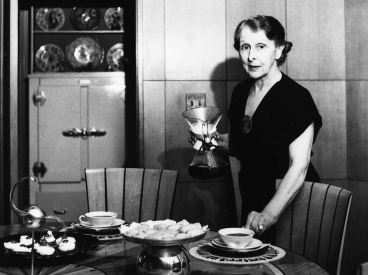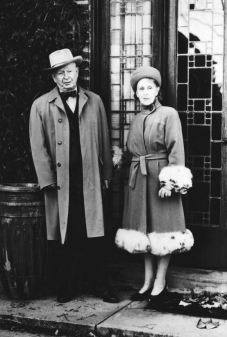Over the years the Kitchen Sink has remembered the stories of Cranbrook Institute of Science Director, Dr. Robert Torrens Hatt. But did you know that his wife of 22 years, Marcelle Roigneau Hatt, was also a respected scientist and exhibition curator?

Marcelle Roigneau Hatt by the “big bomb”, Mexico, ca 1947. Photograph by Robert T. Hatt. Courtesy Cranbrook Archives.
Marcelle was born on October 19th, 1898, in Bordeaux, France, to Hubert and Francine Chetot Roigneau. After moving to America, she took courses at Columbia University in vertebrate zoology, evolution of man, and vertebrate paleontology with Profs. James Howard McGregor and William King Gregory, who both rated her highly among their students. Marcelle worked as a staff assistant in the department of Human and Comparative Anatomy at the American Museum of Natural History (AMNH) in New York. Robert T. Hatt also worked at AMNH from 1928-1935 as the Assistant Curator of Mammals.
Robert and Marcelle were married in 1929. In the Fall of 1930, they traveled together to the Yucatan on a grant-funded expedition to discover evidence of a possible land connection between the Yucatan and the West Indies. The first few weeks were spent at the ruined Maya city of Chichen-Itza where mammals and reptiles were collected. Following this, the Hatts explored a large number of caves in the Yucatan’s low mountains, for the remains of extinct animals. Fossils were obtained in every site excavated, though the numbers were small.
Following the Yucatan expedition, Marcelle was engaged in planning a series of exhibitions as an introduction to Human and Comparative Anatomy. The exhibition, “Top of the World in Yucatan” described her experiences on the expedition with her husband. In 1934, Marcelle was promoted to Assistant Curator in the Department of Comparative and Human Anatomy at AMNH.
In the Spring of 1935, the Hatts moved with their young sons, Richard and Peter, from New York to Michigan when Robert accepted the position of Director of the Institute of Science. In response to her resignation, the Executive Secretary at AMNH wrote in a letter dated March 27, 1935:
“In transmitting your letter of resignation, Doctor Gregory paid high tribute to the excellent work you have done throughout your connection with his Department, emphasizing especially your invaluable assistance in supervising the preparation and installations of exhibits in the hall of “Introduction to Human Anatomy;” your splendid cooperation in the preparation for labels and guide leaflets and in his researches on the evolution of the skull of vertebrates; and the competent manner in which you handled the sale and exchange of casts and models. Congratulating you on this enviable record and assuring you that you carry with you, in your new field of activities, the best wishes of your associates and colleagues.”
Marcelle continued to work on a variety of projects at CIS during the 1930s and 1940s, including photographing specimens, assisting Dr. Hatt on additional field trips to Mexico, and curating an exhibition of Native American baskets that opened in April, 1941.

Exhibition catalog prepared by the Art Project of the Works Project Administration, Detroit, by the silk-screen process. Printed on the Cranbrook Press, 1941.
“Basketry of the North American Indians” opened on Easter Sunday. The exhibition featured examples of baskets from pre-historic cave dwellers to woven hats, snowshoes, and mats of Modern Michigan tribes. Marcelle Hatt organized the display of 183 specimens and the accompanying catalog.
On March 27th, 1951, Marcelle Roigneau Hatt passed away at the young age of 52. Her contributions to Human and Comparative Anatomy live on in the Journal of Mammalogy, Science, and The Science News-Letter of the American Museum of Natural History.
– Gina Tecos, Archivist
Sources:
“Science News.” Science 79, no. 2058 (1934): 8a-11a.
“In Science Fields.” The Science News-Letter 25, no. 684 (1934): 312-13.
Hatt, Robert T. “Notes concerning Mammals Collected in Yucatan.” Journal of Mammalogy 19, no. 3.
The Robert Torrens Hatt Papers, Courtesy Cranbrook Archives/Cranbrook Center for Collections and Research.
The Cranbrook Institute of Science Director’s Papers, Courtesy Cranbrook Archives/Cranbrook Center for Collections and Research.




























